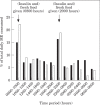Food intake and blood glucose in normal and diabetic cats fed ad libitum
- PMID: 11714241
- PMCID: PMC10822370
- DOI: 10.1053/jfms.1999.0052
Food intake and blood glucose in normal and diabetic cats fed ad libitum
Abstract
Ten diabetic cats were studied at intervals for up to 12 months with twice-daily insulin injections. Ten clinically healthy cats were also studied. Diets fed were based on the individual cat's performance, using mainly commercial dry or canned cat foods and fresh meat. In most cases more than one food was offered. Food was given fresh twice daily, and the cats allowed to eat ad libitum. The food intake and blood glucose were measured every 2 h in diabetic cats after insulin injection and in diabetic and normal cats without insulin injections. Food was quantified by the energy consumed (kJ ME), crude protein (g), crude fat (g), and carbohydrate (g). The blood glucose in 10 diabetic cats was measured for 2 h following a 20-min meal. Both diabetic cats and normal cats showed similar patterns of eating, with a higher food intake in the 2 h after fresh food was placed. Both groups of cats ate multiple small meals spread through the day and night. There was little or no correlation between the blood glucose and the amount of food consumed over the previous 2-h period, in insulin- or non-insulin-treated diabetic cats, or in normal cats. An overnight fast did not significantly alter morning blood glucose in diabetic cats. No demonstrable appetite stimulation occurred following an occurrence of low blood glucose; however, recorded incidences were few. No post-prandial hyperglycaemia was seen in the 10 diabetic cats during a 2-h period following the ingestion of typical cat foods.
Copyright 1999 European Society of Feline Medicine.
Figures





Comment in
-
Cats, diabetes and stress!J Feline Med Surg. 1999 Dec;1(4):197. doi: 10.1053/jfms.1999.0059. J Feline Med Surg. 1999. PMID: 11714235 Free PMC article. No abstract available.
Similar articles
-
Acute appetite reduction associated with an increased frequency of eating in obese males.Int J Obes Relat Metab Disord. 1999 Nov;23(11):1151-9. doi: 10.1038/sj.ijo.0801046. Int J Obes Relat Metab Disord. 1999. PMID: 10578205
-
Effect of dietary carbohydrate, fat, and protein on postprandial glycemia and energy intake in cats.J Vet Intern Med. 2013 Sep-Oct;27(5):1121-35. doi: 10.1111/jvim.12139. Epub 2013 Jul 19. J Vet Intern Med. 2013. PMID: 23869495 Clinical Trial.
-
Pharmacology of a 40 IU/ml porcine lente insulin preparation in diabetic cats: findings during the first week and after 5 or 9 weeks of therapy.J Feline Med Surg. 2001 Mar;3(1):23-30. doi: 10.1053/jfms.2001.0111. J Feline Med Surg. 2001. PMID: 11716627 Free PMC article.
-
Feline diabetes mellitus: low carbohydrates versus high fiber?Vet Clin North Am Small Anim Pract. 2006 Nov;36(6):1297-306, vii. doi: 10.1016/j.cvsm.2006.09.004. Vet Clin North Am Small Anim Pract. 2006. PMID: 17085236 Review.
-
Current understanding of feline diabetes: part 2, treatment.J Feline Med Surg. 2000 Mar;2(1):3-17. doi: 10.1053/jfms.2000.0057. J Feline Med Surg. 2000. PMID: 11716587 Free PMC article. Review.
Cited by
-
ISFM consensus guidelines on the practical management of diabetes mellitus in cats.J Feline Med Surg. 2015 Mar;17(3):235-50. doi: 10.1177/1098612X15571880. J Feline Med Surg. 2015. PMID: 25701862 Free PMC article.
-
Hypercarnivory and the brain: protein requirements of cats reconsidered.J Comp Physiol B. 2011 Jan;181(1):1-17. doi: 10.1007/s00360-010-0528-0. Epub 2010 Nov 19. J Comp Physiol B. 2011. PMID: 21088842 Review.
-
Effect of acarbose on postprandial blood glucose concentrations in healthy cats fed low and high carbohydrate diets.J Feline Med Surg. 2015 Oct;17(10):848-57. doi: 10.1177/1098612X14556559. Epub 2014 Oct 24. J Feline Med Surg. 2015. PMID: 25344379 Free PMC article. Clinical Trial.
-
Dry foods and risk of disease in cats.Can Vet J. 2008 Jun;49(6):561-3. Can Vet J. 2008. PMID: 18624064 Free PMC article. No abstract available.
-
Evaluation of a continuous glucose monitoring system in cats with diabetes mellitus.J Feline Med Surg. 2005 Jun;7(3):153-62. doi: 10.1016/j.jfms.2004.07.006. Epub 2005 Jan 7. J Feline Med Surg. 2005. PMID: 15922222 Free PMC article.
References
-
- Arai T, Washizu T, Sako T, Sasaki M, Motoyoshi S. (1992) D-glucose transport activities in erythrocytes and hepatocytes of dogs, cats and cattle. Comparative Biochemistry and Physiology. Part A, Physiology 102, 285–287. - PubMed
-
- Berger M. (1989) Towards more physiological insulin therapy in the 1990s. Diabetes Research and Clinical Practice 6 (Suppl), S25–S31. - PubMed
-
- Bradshaw J, Thorne C. (1992) Feeding behaviour. In: Thorne C. (ed.), The Waltham Book of Dog and Cat Behaviour. Oxford, UK, Pergamon Press, pp. 115–129.
-
- Buddington RK, Chen JW, Diamond JD. (1991) Dietary regulation of intestinal brush-border sugar and amino acid transport in carnivores. American Journal of Physiology 261, R793–R801. - PubMed
-
- Crenshaw KL, Peterson ME. (1996) Pretreatment clinical and laboratory evaluation of cats with diabetes mellitus: 104 cases (1992–1994). Journal of the American Veterinary Medical Association 209, 943–949. - PubMed
MeSH terms
Substances
LinkOut - more resources
Full Text Sources
Medical
Research Materials
Miscellaneous

